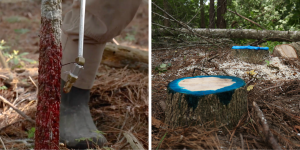
We are excited to share that the UF/IFAS Center for Aquatic and Invasive Plants (CAIP) now has a collection of invasive plant management technique videos available for professionals that tackle problematic woody plants! These videos demonstrate the appropriate way to accomplish various management techniques. Dr. Enloe shares recommendations for herbicide reduction, technical specifications of products, application technology, environmental stewardship, and applicator safety.
The following techniques have a lecture-style series that cover targets, treatments, techniques, timings, tools, and potential trouble you may face when out in the field. An in-the-field series compliments those lectures by taking you out in the woods with Dr. Enloe to show you how these techniques are applied in the real world.
Basal Bark Application
A basal bark application involves combining an herbicide with an oil penetrant and directly applying the mixture to the bark of trees that are less than 6 inches in diameter and have smooth bark. View the basal bark videos here.

Cut Stump Application
The cut stump technique should be used after cutting down a tree to help reduce regrowth. After removing the sawdust from the stump, apply the herbicide solution to the cut surface. Apply the herbicide solution to the outside edge of the stump if it is larger than 3 inches in diameter. You can apply the solution to the entire surface of smaller stumps. The herbicide solution will vary depending on the timing of application. View the cut stump videos here.
Reduced Hack and Squirt Treatments
A reduced hack and squirt treatment requires cutting through the thick bark and into the sapwood with a machete or hatchet. Then, using a spray bottle to apply a small amount of herbicide solution into the hack (about 0.5 to 1.0 ml). This technique is recommended for large trees that are not near roadsides or parks to avoid safety issues. View the reduced hack and squirt treatment videos here.

For a more in depth description of these techniques you can visit the AskIFAS document titled: Herbicide Application Techniques for Woody Plant Control. All technique videos can be found on the UF/IFAS CAIP website. If you have any questions, please email Dr. Stephen Enloe, professor and invasive plant management Extension specialist.
This project was funded by the Florida Fish and Wildlife Conservation Commission.
Follow UF/IFAS CAIP on Instagram, and LinkedIn. Subscribe for more blogs like this one.
UF/IFAS Center for Aquatic and Invasive Plants. Turning Science Into Solutions.
Did you find this post helpful? Click the heart below!
 4
4
